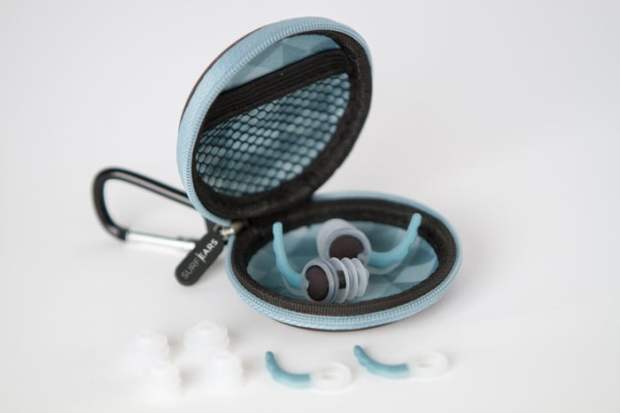
Being a surfer in Northern California has its challenges. The water is cold. Currents can be exhausting and beat downs from powerful, storm-spawned waves come with the territory. And don’t forget marauding, school bus-sized sharks.
While it’s a little more mundane, I struggle to keep my ears healthy. I’m prone to swimmer’s ear in my right ear, and I’ve got early stage surfer’s ear in my left. I’ve worn ear plugs, but I don’t like them. They can fall out as I tumble underwater, and they deaden ambient sound to make me feel like I’ve got a head cold.

So I was stoked to hear about SurfEars, a new ear plug wrapping up a successful crowdfunding campaign. SurfEars’ is a product from Frankly Development, a Sweden-based “product creation agency.” They have come up with an ingenious design I think will reinvent ear plugs for surfers and water sport enthusiasts that sounds too good to be true: they keep the water out, but let sound in. Little, ergonomically designed support wings keep them in place. (A good thing since a pair costs $70). And they work.
This past weekend I took no less than a dozen icy waves on the head and my ears stayed dry and the plugs remained comfortably in place. In between repeated submersions, conversations with fellow surfers was so easy it was almost like not wearing ear plugs at all. The ear plugs are covered with an acoustic mesh that lets sound in but keeps water out. SurfEars claims close to zero acoustic loss.
SurfEars were born from CAD and rapid prototyping and are part of the growing, yes, wave, of consumer products iterated via 3D printing.


I asked Frankly Development’s Tobias Mårtensson about the SurfEars:
Tell me about the design team behind SurfEars?
Frankly Development is based in Sweden, but one of our lead engineers is from Australia. Since Frankly started creating products for our clients in 2011 the team has grown in size, but even more important in the range of areas we offer our services. The initial team were specialists within concept development, mechanical design, supplier management, and manufacturing from Nokia. All with a burning passion to create innovative products, travel the world, and have a lot of fun together!What was the inspiration for SurfEars?
The project was kicked off in 2011 as a result of one of the inventors (an experienced surfer with fully developed surfer’s ear) catching a serious ear infection during a surf trip to Morocco. Totally deaf on one ear, the ear infection lasted for a week and was a real pain to get rid of. Having tried nearly all ear plugs on the market without satisfaction, we thought it was time to develop our own product that really works. We needed the product to protect our ears from cold air, water, dirt, and bacteria without affecting hearing or balance, which are import and aspects of your experience when surfing or doing other water sports. We thought it was important that the product allowed you to hear what’s going on around you and let you keep a normal conversation on and off the water. We wanted a product so comfortable to use that you could keep it in your ear for hours without even thinking about it.How was 3D printing used?
Our 3D printer (a Makerbot Replicator) is a priceless tool for concept verification and has been running nonstop since project kick-off. It enabled us to do countless iterations of prototypes, eventually leading up to the final design.How are they made in full production?
The plastic core is made with injection molding of polycarbonate. The fixation wings are made with 2-shot silicone injection molding with a different hardness to obtain desired functionality. The gels [the part the enters the user’s ear] are made with silicone injection moulding.How does the acoustic mesh work? Why isn’t it water permeable?
The acoustic mesh is a material specifically developed for acoustic solutions in hearing aids, headsets, and earphones, as well as mobile phones. There are several types of meshes to choose from depending on what level of sound permeability and water protection you need. The mesh consists of a fine-woven polyester fabric, treated with a hydrophobic coating to keep water from sticking to the surface. The mesh we’ve selected has just the right balance between sound permeability and protection of water ingress to let you hear what’s going on around you while protecting your ears from water, cold air, and other bad stuff.$70 seems expensive. How did you arrive at the price?
The feedback we have been getting from distributors and other shops is that it will perform well at this sales price based on previous experience from competitor products. In fact, SurfEars is priced lower and performs much better than its closest competitors on the market.
In spite of its nichey application, SurfEars offer a “why-didn’t-I-think-of-that” design that I think will become the new standard. If you had the choice, why not go for an ear plug that offers comfort, water protection, and the ability to hear your surroundings? Now if they’d just come up with a shark protection device.
ADVERTISEMENT
Join Make: Community Today










